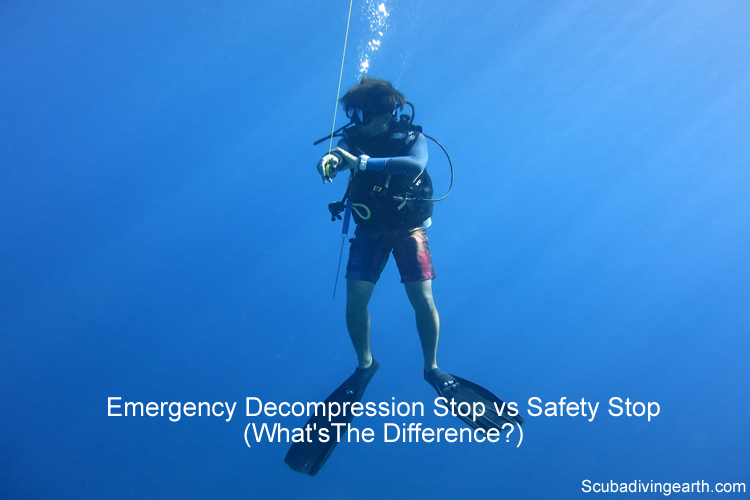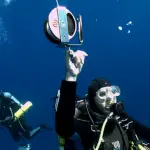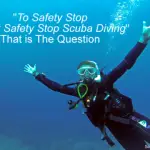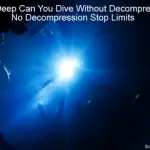
Emergency decompression stop vs safety stop and what’s the difference between them
Emergency Decompression Stop vs Safety Stop: Save diving practices include carrying out a safety stop on all your dives at 6 metres (20 feet) on your way to the surface after a dive. Whereas an emergency decompression stop is required where the no stop time limit for your dive has been exceed by accident.
The best way to do more diving and to practice your safety stops, is to book yourself on a scuba diving liveaboard. You can check the latest and best deals on liveaboards using the following window:
It’s always good practice to consider EVERY dive as a decompression dive. By doing so you will approach your dive ascents differently.
If you follow safe diving practices (which I recommend you do) you will perform a safety stop on every scuba dive you do.
Additionally, you must dive within recreational dive depth limits according to your scuba diver certification level and diver experience. This means that you’ll only dive within safe no stop time limits.
But where these are exceeded by accident, you should carry out emergency decompression stops. In addition to a safety stop at 5-6 metres (16-20 feet) for a minimum of 3 minutes.
What is the decompression stop?
Before I explain what the decompression stop is, it’s better to understand what decompression is.
Definition of decompression
If we look at the definition of decompression this states that: “decompression is to release from pressure or compression” or “to undergo release from pressure.”
When you dive, you are entering an environment which is at higher pressure than it is on land.
The deeper you go, the higher the pressure.
So by definition, as you ascend from ANY dive your body will be decompressing.
This is why all scuba diving schools, navy training and other scuba diving experts advise you ascend at a slow rate. (See below: What is the recommended ascent rate for recreational divers or how fast can you surface when scuba diving?)

Why is decompression important for scuba divers?
If all divers were to consider every dive as a decompression dive, the risks associated with decompression sickness would reduce.
Decompression is important for scuba divers because under pressure gases in the air we breathe are dissolved into our body tissues.
This is particularly true of and important for nitrogen, as this makes up around 80% of atmospheric air.
Nitrogen is easily absorbed by our body under pressure.
As we dive deeper the higher the pressure becomes and the more nitrogen is dissolved. Also, the longer we dive and the more time that elapses, the more nitrogen is dissolved in our body.
When we ascend and the body decompresses, the dissolved gases are released from your body tissues. But we want the release of those gases to be slow and controlled. Thereby avoiding the formation of bubbles.
Therefore, on your ascent from a scuba dive it’s important to allow time for these gases (and in particular nitrogen), to be released.
The way this is done is to ascend slowly (See below. But also to stop at certain depths (decompression stops) for certain intervals where the diver has entered what I always refer to as a decompression stop dive, or what others refer to as a decompression dive.
But by referring to a dive which requires decompression stops as a decompression dive, implies that all other dives are not decompression dives, which is simply not true.
Please take away from this article: All scuba dives are decompression dives. No matter how deep you go. No matter how long you dive for, your body will dissolve nitrogen into your bodily tissues. This means that you will always need to take care on the ascent to allow for the nitrogen to decompress slowly.
What is a decompression stop?
So a decompression stop in diving is an interval of time where a scuba diver stops for a certain amount of time in order to aid the process of decompression.
A decompression stop dive is where the diver must make decompression stops to allow the gases to escape slowly. Guidance for the timing and depth of these decompression stops needed for a decompression stop dive are provided by decompression tables or from using dive computers.
If this is not done correctly, where the ascent is either rushed or where decompression stops are missed when required, these gases will release too quickly and bubbles will form.
Where bubbles form in this way, this will likely lead to decompression sickness (DCS) or the bends. The consequences of DCS can be mild or severe, which is dependent on where the bubbles form and what happens to them in the body.
Decompression stop dives are for more advanced divers. Most recreational dives are done on a no decompression stop basis within the no stop time limits.
What is an emergency decompression stop?
Where a recreational diver is diving on a no-decompression dive, but for whatever reason he exceeds his dive time so that the dive becomes a decompression stop dive, he will have to do an emergency decompression stop.
Guidance for the length of the decompression stop time and the depth at which this is done is provided by diver decompression tables. However, all dive computers will also provide this information too.
If you are on a dive and, for whatever the reason, you slip into decompression stop time, which requires you to perform an emergency decompression stop, you must do this to avoid getting decompression sickness or the bends. This is also referred to as decompression illness too.
Where your dive time slips accidentally into requiring an emergency decompression stop, your dive computer will indicate the decompression stop required. Your computer will indicate this in terms of the depth and time required at that depth.
Air management is key to your decompression stops
Having to perform an emergency decompression stop requires you to have more air. So where your air is not sufficient to stop for the required time, you will have to return to the surface without the required stop.
However, you’ll probably have to consider going to a recompression unit or hperbaric chamber and be treated for decompression sickness.
If you’re diving without a dive computer, PADI provide a recommendation on their dive tables, as follows:
Emergency Decompression: “If a no decompression limit is exceeded by no more than 5 minutes, an 8 minute decompression stop at 5m is mandatory. Upon surfacing, the diver must remain out of the water for at least 6 hours prior to making another dive. If a no decompression limit is exceeded by more than 5 minutes, a 5m decompression stop of no less than 15 minutes is urged (air supply permitting). Upon surfacing, the diver must remain out of the water for at least 24 hours prior to making another dive.”
Others recommend doing a safety stop at a depth which is half that of your maximum dive depth. So if your dive was to 30 meters (100 feet), you should stop for decompression at 15 metres (50 feet) for at least 2 minutes.
Then continue to stop at 10 metre (33 feet) intervals for a further one minute at each depth. Do this until you reach 5-6 metres (16-20 feet) for your final 3 minute safety stop. But in this case and air permitting, make this safety stop 5 minutes instead.
How long is a decompression stop?
The length of each decompression stop will vary. The variables for a decompression stop will depend on the length of time of your dive and on the depth of the dive.
The easiest way to manage your decompression stops is to use a dive computer. However, when I first learnt to dive, we worked with decompression tables and a depth gauge. At that time dive computers were not trusted.
As with all dives, a dive that is going to be a decompression stop dive must also be planned carefully. This is important, as you have to allow for air consumption time to cover your whole dive. This includes the ascent time, which includes the time for decompression stops. Which can be more than one.
Holding the correct scuba diver certification
If you plan on doing a decompression stop dive, you must first hold the correct scuba diving certification for this level of scuba diving. Plus you must take a backup plan to your dive computer.
As with all dives you should be diving in buddy pairs in any case, and your buddy will hopefully also have a dive computer.
More Reading: How do I get a dive buddy? (5 easy ways to find a dive buddy)
However, what if both your computers fail? Or more probable, what if you get separated on the dive and your computer has failed? In this case you need to know what the planned stops for the depth and time of dive you should be doing (i.e. these should have been planned before the dive).
You should also have with you a separate depth gauge. this will tell you your depths on ascent so you know when to stop.
In this event, instead of using your dive computer to monitor the decompression stop, you’ll be using your dive watch instead.
What is a safety stop in scuba diving?
A safety stop in scuba diving is where a diver stops at a certain depth during his ascent to the surface, in order to make sure they’ve decompressed sufficiently, before completing the ascent.
It’s always worthwhile remembering that ALL dives are decompression dives. But only certain dives that are deemed to require decompression stops. This is when the dive is to particular depths for certain bottom times. It is where more time is require to decompress during the ascent.
So if you view a dive in this way, where your body is having to decompress for any depth or length of dive, you’re more likely to follow the extra safe principle of carrying out a safety stop in any event.
How long is a safety stop in scuba diving?
A safety stop is a controlled stop on a non-decompression stop dive where a recreational scuba diver stops at between 5-6 metres (16-20 feet) for between 3-5 minutes.
The decompression tables and the software that’s used to run dive computers using certain algorithms.
However, every scuba diver’s body is different. People are different weights, at different levels of hydration and are physiologically different in many other aspects. Which means that we will all decompress at different rates.
Also, the rate of decompression will be affected by how many dives you’ve done previously too. So with the amount of factors that could affect how fast you’ve decompressed at the point you reach 6 metres (20 feet), you are better off waiting for three minutes to be safe rather than sorry. It’s only three minutes after all.
If necessary, and if you are diving in clear blue seas, use the time to look and watch, as you never know what you may see.
One time in the Red Sea we were joined by a turtle. We discovered we were surrounded by bits of jellyfish. The turtle had come to eat the jellyfish. What was amazing is that I held some of the pieces of jelly fish and the turtle ate them from my hand. This all happened at around 6 metres (20 feet).
A priceless experience and one that may never happen again!
Why do divers do a safety stop?
Divers do a safety stop purely as a precaution. It’s much better to be cautious. Make sure that the body has decompressed sufficiently, before the final 6 metre (20 feet) ascent to the surface.
It’s good safe diving practice to do a safety stop on any dive you do.
There are some of the scuba dive organisations that consider it mandatory to do a safety stop for dives that are deeper than 30 metres (100 feet). This also applies to dives that are on the limit of no decompression stop limit.
What you’ll find on most dives you do with PADI dive centres is the dive master will ask all divers in the group to perform a 6 metre (20 feet) safety stop.
What is no stop time in scuba diving?
The no stop time for a scuba dive is the time you can spend on your dive at a certain depth. But without having to carry out any decompression stops.
This is also referred to as a no decompression limit (NDL) by some divers. Which to my way of thinking is confusing and a potentially dangerous. For me it’s not a no decompression limit, but a no stop time limit, or a no decompression stop time limit.
As I explained above, all dives are decompression dives. As no matter how deep you go, your body will begin to dissolve nitrogen into its tissues. It’s then a matter of how much time and how much depth you dive which defines how much nitrogen you absorbed. So in my opinion there are no limits to decompression, but only a matter of quantity.
There are set limits for no stop times for all depths of dive. Each depth will vary in the amount of time before you must return to the surface to avoid going into decompression stop time.
The emergency decompression stop
If you planned a no stop time dive, but for whatever reason you’ve slipped over the no stop time limit, this is when you must do an emergency decompression stop.
Decompression tables provide the information for no stop times for dives and can be used for planning your dive. However, all dive computers will compute your no stop time and over the course of your dive. A computers count-down will be run as you approach your no stop time limit.
It’s always advisable to dive within no stop time limits, unless you have planned for a decompression stop dive at the outset. Plus you have the necessary qualifications and experience to do a decompression stop dive.
The other factor that affects your no stop time is how many dives you’ve done immediately prior to the current planned dive.
The reason why the no stop time increases, is because the tables allow for the nitrogen that still remains dissolved in your body tissues from the previous dive(s).
In this case the no stop time is reduced according to the depth of the previous dive and the length of the dive interval. Which means the time between when you surfaced from the last dive and the time you intend to descend on your next dive.
What is the recommended ascent rate for recreational divers or how fast can you surface when scuba diving?
The BSAC 88 Decompression Tables allow for an ascent rate of 15 metres (49 feet) per minute up to 6 metres (20 feet). BSAC then allows for 6 metres (20 feet) per minute to the surface.
However most dive computers and decompression/dive planning software incorporate ascent rates of either 9-10 metres (29-32) per minute throughout the ascent to the surface.
However, many incorporate a safety stop at between 5-6 metres (16-20 feet). The final ascent rate from this safety stop of 6 metres (20 feet) per minute to the surface.
The ascent rate for US divers is around 9 metres (30 feet) per minute. Which was changed from their original 18 metres (60 feet) per minute rate.
If you are ever in doubt or have no other device to aid the speed of your ascent from a scuba dive, follow behind the smallest bubbles you generate from your breathing exhaust bubbles. These will be the size of Champagne bubbles.
The back-stop method of ascending from a dive is to ascend at a rate which is less than the smallest bubbles generated in the water from your exhaust bubbles. These are the bubbles that are smaller than the bubbles created in Champagne.
How do you ascend when scuba diving?
The first safety rule when ascending from your dive, which has already been explained above, is to ascend slowly form your dive.
Secondly, the best way to start your ascent is to slowly push yourself up either using your arms or your fins until you become positively buoyant. As you do this you will naturally begin to ascend from the bottom.
Never use your buoyancy control device to start your ascent by inflating it with additional air. As this could cause you to ascend too quickly and be out of control.
As your ascent progresses you will need to let air out of your buoyancy control device (BCD) using one of the dump valves. Alternatively, if you’re dry-suit diving, you will need to dump air from one of your dry suit dump values too.
Control your ascent rate and stay safe
The idea of a safe ascent is to keep your ascent rate controlled. This is achieved by carefully letting small amounts of air out from your BCD. You need to be careful not to let too much out at a time.
If you let too much air out at the wrong time, you’ll become negatively buoyant and begin to descend again. If this does happen, it’s not a problem and you can normally correct this by some gentle finning to get you back to a positive buoyancy state.
Also, if you don’t let enough air out at the right times, your ascent will become too fast. So its a balance of letting just enough air out to control your speed to the correct ascent rate. If you have a dive computer, this will guide you on your ascent. It will indicate to you whether or not your speed is too fast or not.
Computer audible warnings help with ascent rates
Where your ascent rates gets dangerously fast, your dive computer will being to warn you audibly. If this happens you need to dump more air from your BCD to slow your ascent rate down.
It’s important to understand, the closer to the surface you get, the more quickly the pressure of the water changes. The biggest change in water pressure is between 10 metres (33 feet) and the surface, where the pressure halves.
In this part of your ascent be extra careful and prepare to start dumping more air from your BCD. Especially if your computer is programmed to have a slower ascent rate in the final 6 metres (20 feet).
As you approach the surface watch and listen. It’s also good practice to pivot around 360 degrees and look up and around for any obstacles. Also, before you break the surface put the arm that’s not controlling the BCD dump valve above your head.
This is to protect your head in the case of an obstruction, as it’s always better for your arm to hit something than you head, or better still not to hit anything at all.
What is it called when a diver comes up too fast?
When a diver ascends faster than he should and becomes ill as a result, this is called decompression sickness.
Scuba divers breathe compressed air when they are underwater, and as already explained the nitrogen gas in the air they breathe dissolves into a diver’s body tissues.
When a diver comes up too fast, the nitrogen forms bubbles and is what causes the decompression illness.
Can you die from the bends?
Scuba divers should avoid the bends at all costs. The best case scenario of decompression sickness is for a diver to get what’s known as a skin bend. A skin bend is a rash on the surface of the skin caused by the nitrogen escaping.
The worst case scenario in extreme cases for decompression sickness is death. For example in May 2009 a National Geographic diver died from the bends (decompression sickness) whilst filming in Greece.
There are around 300 reported cases of decompression sickness in the UK every year. The symptoms of decompression illness can occur quite rapidly or they can take hours or even days after a dive before the sufferer becomes aware of their decompression sickness.
What are the signs and symptoms of decompression sickness?
There are a number of symptoms that manifest from decompression sickness, which include the following:
Type 1 decompression sickness
- Skin rashes, which is known as a skin bend, which can cause itchiness.
- Pain, which tends to be in the joints.
- Headaches, feeling light headed, feeling tired or fatigued.
Type 2 decompression sickness (more serious)
- May begin with or include type 1 symptoms.
- Numbness or paresthesia. Which is a burning or prickling sensation like ‘pins and needles.’ This is usually felt in the hands, arms, legs or feet.
- Inner ear problems resulting in vertigo, dizziness and tinnitus (ringing in the ears). These symptoms can also lead to nausea and vomiting.
- Cardiopulmonary symptoms, also known as “the chokes. ” These symptoms can include a dry cough, chest pain.
- Respiratory problems where bubbles have formed in the lungs. This causes breathing difficulties which in more serious cases can cause death.
Whatever level of the symptoms and if you have any inkling that there’s a possibility of having decompression sickness, seek urgent medical assistance.
How is decompression sickness treated?
If you suspect or you know that a diver is suffering from decompression sickness, you must first put them on oxygen.
Whilst they are on oxygen they need to be transferred to a recompression or hyperbaric chamber as quickly as possible.
This could involve speaking with the coast guard. The coast guard will call to arrange for an immediate pickup of the diver. Which in some cases will involve being collected by helicopter.
Time is of the essence when a scuba diver has the bends. It’s important for them to be re-pressurised back to depth to re-compress the bubbles of nitrogen back into the body tissues. This is before they cause serious damage or worse still death.
The hyperbaric chamber will re-pressurised the diver to depth once more. They are then slowly brought back up to atmospheric pressure once more.
How deep can you dive with scuba gear?
Outside of natures limits on how deep scuba divers can dive, your maximum diving depth is regulated from a safety perspective relating to your scuba diver certification level.
Also, different scuba organisations have different maximum depths for the levels of qualification. For example a PADI deep diver is qualified to dive to 40 metres (130 feet), whereas a dive leader in BSAC is qualified to dive to 50 metres (164 feet).
The first limitation after that relates to the toxic effects of the oxygen content of atmospheric air, which is at about 21% or air. Scuba divers breathing air at depths beyond 60 metres (197 feet) face an increasing risk of oxygen toxicity.
This is why technical divers that dive to depths in excess of 60 metres use mixed gases, which reduce the oxygen content in the air they breathe.
Beyond that the other limiting factor becomes the pressures that gets greater and greater, the deeper you go. However, a world record was set by an Egyptian diver who dived to about 1,090 feet in the Red Sea. This is the deepest dive ever by a scuba diver!
The funny fact about this extreme scuba dive was that it took Gabr just 12 minutes to reach the 1,090 depth, but then the rest of the day (14 hours) to ascent back to the surface again, to avoid any decompression problems.
To enable the dive for such a length of time, he dived with nine air tanks.
Can you get the bends from a long snorkel?
It is highly unlikely to get the bends from snorkeling. As the majority of your time is spent on the surface of the water when you’re snorkeling.
When you dive down using a surface dive when snorkeling, the time spent underwater is limited by the length of time you can hold your breath. Which in most cases is very short.
In the short time span between diving down and having to come back to the surface, it’s unlikely you’ll get much deeper than 4-5 metres (13-16 feet). Unless you are extremely good at holding your breath. If you dive down with excessive repetition, the chances of you getting the bends when snorkeling would be very unlikely.
What needs to happen is for nitrogen to build up in your body over time at depth. So unless you are spending enough time at a deep enough depth, you are unlikely to build up the level of nitrogen to get the bends.
For example, on the BSAC dive tables the no stop dive time at 9 metres (30 feet) is 243 minutes. Plus that’s at 9 metres for the whole time of 243 minutes. Which is over four hours. So if a snorkeler is able to spend more than four hours at 9 metres, I’be amazed.
However, the free divers that are able to hold their breath for extremely long periods and dive down to extreme depths, then in this case there is a possibility of them getting the bends. But again, its extremely unlikely and assuming they ascend slowly, the risk will be low.
They are more likely to have asphyxiation or drowning problems over decompression problems.
More Reading: What should you not do after scuba diving (11 must NOT do’s after diving)
I hope you enjoyed this article about emergency decompression stop vs safety stop
I’d love to hear from you. Tell us about your adventures of diving and snorkeling, in the comments below. Please also share your photos. Either from your underwater cameras or videos from your waterproof Gopro’s!
If this article hasn’t answered all of your questions. If you have more questions either about snorkeling or scuba diving (or specifically about emergency decompression stop vs safety stop), please comment below with your questions.
There will also be many more articles about scuba diving (and snorkeling) for you to read and learn about these fabulous sports.
Have fun and be safe!





